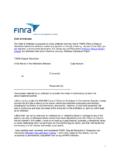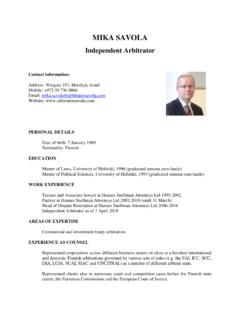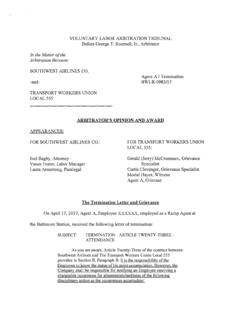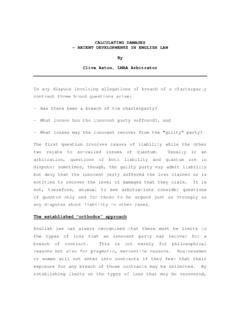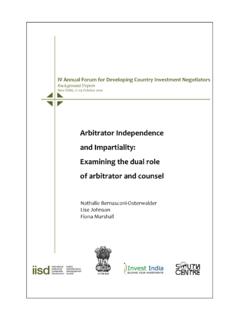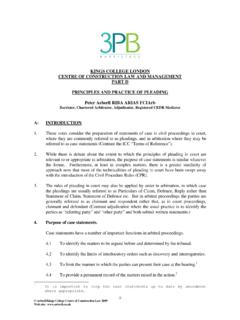Transcription of WRITING THE GRIEVANCE ARBITRATION BRIEF
1 Dr. T Williams WRITING the GRIEVANCE ARBITRATION BRIEF 1 WRITING THE GRIEVANCE ARBITRATION BRIEF by Timothy Williams I. INTRODUCTION One authority has defined the BRIEF as a survey of the potential proof for one side of a A second authority defines the BRIEF as a systematic presentation of arguments, authorities, and relevant background material designed to aid in the decision-making In labor ARBITRATION the written BRIEF is rarely used for an expedited hearing, but is frequently used in a regular GRIEVANCE proceeding. At times the parties use the written BRIEF to supplement final closing oral arguments; while at other times it is used in lieu of oral arguments.
2 Whether used to supplement or in substitute, a well-written BRIEF does such to advance the position of the advocate and, in fact, may be the deciding factor in a case. As such, the craftsmanship and persuasiveness of the BRIEF are vitally important to the advocate s interest. This section of the monograph will summarize many of the basic and technical rules covering style, form and substance 1 Glen E. Mills, Reason in Controversy, Allyn and Bacon, Inc., Boston, 1964, p. 184. 2 Board of Student Advisers, Harvard Law School, Introduction to Advocacy, 2nd ed.
3 , The Foundation Press, Inc., Mineola, NY, 1976, p. 34. Dr. T Williams WRITING the GRIEVANCE ARBITRATION BRIEF 2 that are important for effective BRIEF WRITING . In reading the following materials, the advocate should not lose track of the fact that the primary purpose of the BRIEF is one of influencing the arbitrator s decision. A BRIEF which is technically well-written but unpersuasive is of little value. This is not to infer that rules of style and form necessarily subtract from the persuasiveness of the BRIEF . To the contrary, the essential message of this chapter is that rules of style and form, if applied with persuasiveness in mind, will enhance the overall effectiveness of the BRIEF .
4 The BRIEF is comprised of a number of different sections, each of which will be analyzed separately. It is important, however, also to view the BRIEF as a whole. The advocate should bear in mind that the various sections ought to work together to present the arbitrator with a systematic and logical case designed to favorably influence the final decision. Most important, since the arbitrator s knowledge of the case is normally quite limited, the BRIEF should be critically examined to insure that it is complete, comprehensive and easily understood.
5 Dr. T Williams WRITING the GRIEVANCE ARBITRATION BRIEF 3 II. FORMAT A. Title Page The title page provides the relevant identifying information about the case and should be placed on the front of the BRIEF . Illustration 1, which follows, is a sample of a title page and represents one of many formats that can be used. Regardless of the format, however, the following information should be included: 1. The names of the parties to the action; 2. The name of the grievant; 3. A statement identifying the document as a BRIEF for an ARBITRATION proceeding; 4.
6 A statement identifying the party for whom the BRIEF is being written (Union or Employer); 5. An identifying number if appropriate such as an AAA or FMCS case number; 6. The name of the arbitrator to whom the BRIEF is being submitted; 7. The names of the spokespersons for each party. B. Table of Contents The table of contents serves a double purpose. First, it allows the arbitrator to locate the various parts of the BRIEF quickly. Second, a properly executed table of contents provides a summary of the major arguments and sub-arguments advanced by the advocate.
7 Thus the arbitrator is quickly able both to overview the major lines of analysis advanced by the advocate and to locate the text on each argument. Dr. T Williams WRITING the GRIEVANCE ARBITRATION BRIEF 4 Illustration II is a sample table of contents. A review of that sample provides an overview of how to construct a proper table of contents and also offers a suggested format for structuring the BRIEF as a Several aspects of the style and format found in the sample BRIEF deserve special comment. First, the argument section is set out separately from the materials found in the introduction and conclusion sections.
8 Thus the format clarifies for the reader that the introductory and concluding materials are there for purposes of clarifying, supporting and reinforcing the body of the BRIEF -- the arguments. Second, the arguments themselves are highlighted in three separate ways: 1) the main arguments are set to the furthest left margin, 2) the arguments are set in all capital letters, and 3) the arguments are underlined. Clearly this format should leave no doubt in the arbitrator's mind as to the essential lines of argument and analysis being advanced by the advocate. Third, where a main argument is complex, the recommended format encourages the advocate to provide in the table of contents an outline of the sub-arguments both for the purpose of helping the arbitrator to understand the complexities of an argument and to allow for an easy reference to the supporting text.
9 3 The sample BRIEF is modeled after a recommended format for submitting a legal BRIEF to an appellate court (supra, pp. 36-37). The author of this article believes that the format for WRITING a legal BRIEF can be effectively adapted to BRIEF WRITING in GRIEVANCE ARBITRATION disputes. Dr. T Williams WRITING the GRIEVANCE ARBITRATION BRIEF 5 ILLUSTRATION I TITLE PAGE IN THE MATTER OF THE ARBITRATION ) THOMAS WHITE ) BETWEEN ) ARBITRATOR ) INTERNATIONAL FEDERATION OF ) PROFESSIONAL AND TECHNICAL ) ENGINEERS, LOCAL 85, AFL-CIO ) ) "THE UNION" ) ) AND ) ) THE CITY OF PORTLAND ) Reclassification GRIEVANCE ) Susan Jones, Grievant "THE EMPLOYER" ) AAA File No.
10 75-390-0127-84 ---------------------------------------- ------------- UNION'S POST HEARING BRIEF ---------------------------------------- ------------- Representing the Union: RICHARD KINGMAN business Representative Representing the City: LEON WILLIAMS Assistant City Attorney Dr. T Williams WRITING the GRIEVANCE ARBITRATION BRIEF 6 ILLUSTRATION II TABLE OF CONTENTS INTRODUCTION Page A. Background 3 B. Statement of the Issue 4 C. Statement of the Case 4 D. Applicable Contract Provisions 8 ARGUMENTS FOR THE GRIEVANT I. THE GRIEVANT SHOULD BE RECLASSIFIED TO THE ADMINISTRATIVE 11 SPECIALIST I CLASSIFICATION BECAUSE SHE HAS LEAD WORKER RESPONSIBILITY A.
